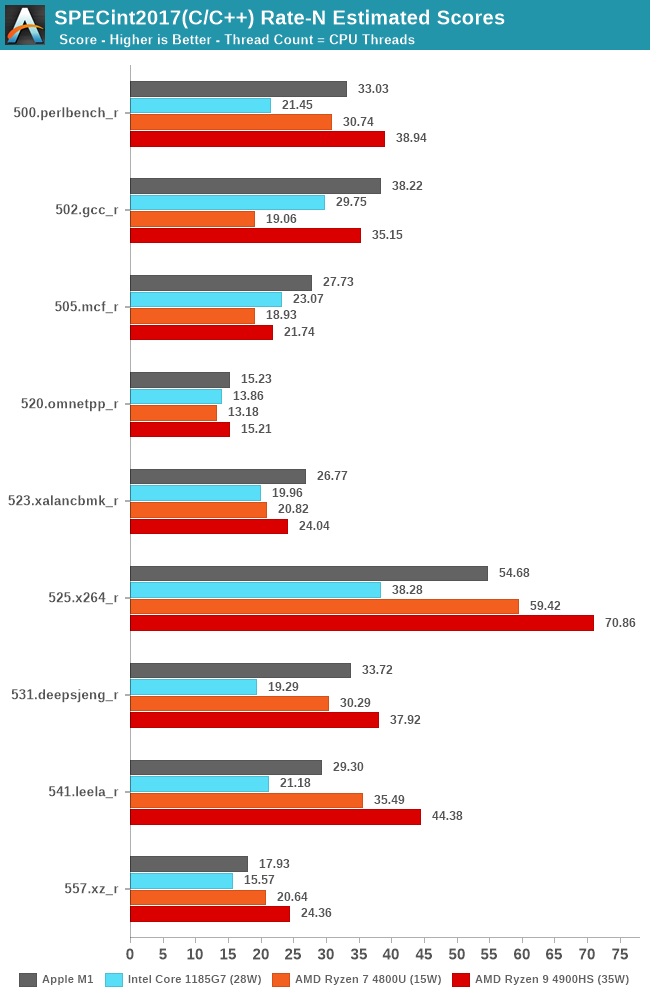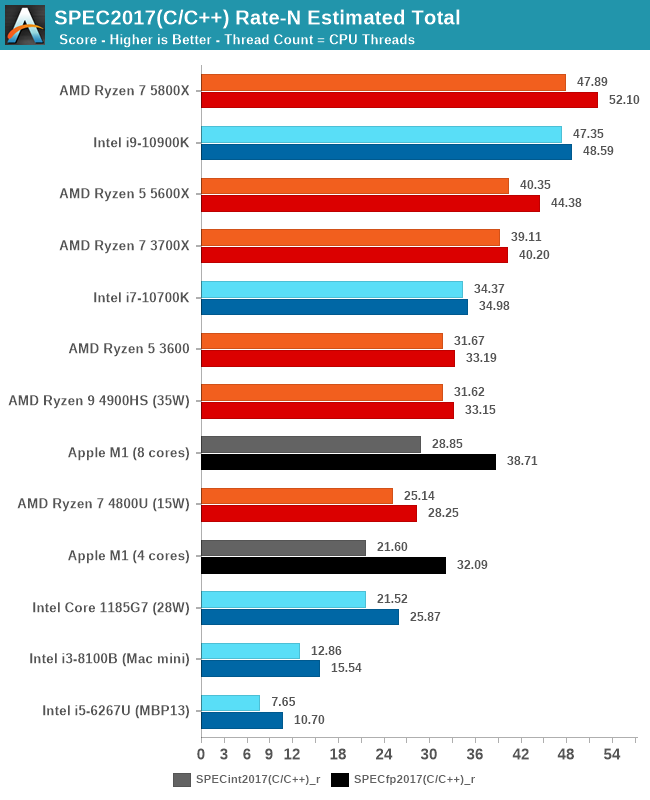The 2020 Mac Mini Unleashed: Putting Apple Silicon M1 To The Test
by Andrei Frumusanu on November 17, 2020 9:00 AM ESTSPEC2017 - Multi-Core Performance
While we knew that the Apple M1 would do extremely well in single-threaded performance, the design’s strengths are also in its power-efficiency which should directly translate to exceptionally good multi-threaded performance in power limited designs. We noted that although Apple doesn’t really publish any TDP figure, we estimate that the M1 here in the Mac mini behaves like a 20-24W TDP chip.
We’re including Intel’s newest Tiger Lake system with an i7-1185G7 at 28W, an AMD Ryzen 7 4800U at 15W, and a Ryzen 9 4900HS at 35W as comparison points. It’s to be noted that the actual power consumption of these devices should exceed that of their advertised TDPs, as it doesn’t account for DRAM or VRMs.

In SPECint2017 rate, the Apple M1 battles with AMD’s chipsets, with the results differing depending on the workload, sometimes winning, sometimes losing.

In the fp2017 rate results, we see similar results, with the Apple M1 battling it out with AMD’s higher-end laptop chip, able to beat the lower TDP part and clearly stay ahead of Intel’s design.

In the overall multi-core scores, the Apple M1 is extremely impressive. On integer workloads, it still seems that AMD’s more recent Renoir-based designs beat the M1 in performance, but only in the integer workloads and at a notably higher TDP and power consumption.
Apple’s lead against Intel’s Tiger Lake SoC at 28W here is indisputable, and shows the reason as to why Apple chose to abandon their long-term silicon partner of 15 years. The M1 not only beats the best Intel has to offer in this market-segment, but does so at less power.
I also included multi-threaded scores of the M1 when ignoring the 4 efficiency cores of the system. Here although it’s an “8-core” design, the heterogeneous nature of the CPUs means that performance is lop-sided towards the big cores. That doesn’t mean that the efficiency cores are absolutely weak: Using them still increases total throughput by 20-33%, depending on the workload, favouring compute-heavy tasks.
Overall, Apple doesn’t just deliver a viable silicon alternative to AMD and Intel, but actually something that’s well outperforms them both in absolute performance as well as power efficiency. Naturally, in higher power-level, higher-core count systems, the M1 can’t keep up to AMD and Intel designs, but that’s something Apple likely will want to address with subsequent designs in that category over the next 2 years.










682 Comments
View All Comments
thunng8 - Sunday, November 22, 2020 - link
What are the cinebench results of the 4800u running at 15w. All I see is the 4800u running benchmark it is well over 40w.For example here: https://www.notebookcheck.net/The-Ryzen-7-4800U-is...
Power usage peaks at 57w and in games the laptop maintains 49w indefinitely. That is very very far from 15w.
Anandtech has actually test the m1 with fan in the mini and it uses 15w in cinebench and scores 7700. The non active cooled MacBook Air uses 7w when thermally throttled (this is in the 30min run) and scores approx 6000
BushLin - Sunday, November 22, 2020 - link
notebookcheck are testing a 4800U in 25W mode and stressing CPU+GPU simultaneously.Here's accurate charts of the 4800U in 15W mode.
https://www.anandtech.com/show/16084/intel-tiger-l...
thunng8 - Sunday, November 22, 2020 - link
Here is some actual figures for a Renoir system.https://forums.anandtech.com/threads/new-apple-soc...
Constrained to 25w, it score 6600.
While m1 scores 7700 at 15w.
https://twitter.com/i/web/status/13287773335122780...
The 4800u would be using 40w+ to outperform the m1 at 15w.
BushLin - Sunday, November 22, 2020 - link
Results are for a different, 4700U CPU, posted by some random person.Why not simply look at the results from the article you're leaving a comment on? Which are more likely to be taken under controlled conditions.
thunng8 - Sunday, November 22, 2020 - link
I am looking for actual performance results at 15w, not boosted to 40w or higher which all 4800u seems to do.BushLin - Sunday, November 22, 2020 - link
Didn't take much effort to find the 15W M1 and 15W 4800U have very similar power draw, if that's what you're actually looking for.They both boost above their rated power in a similar way.
https://images.anandtech.com/graphs/graph16252/119...
https://images.anandtech.com/doci/16084/Power%20-%...
thunng8 - Sunday, November 22, 2020 - link
I was looking for specific cinebench results which you alluded to was running faster than M1 while using the same power. The few videos I have seen shows the 4800U laptops fan spinning up to maximum over most of the entire Cinebench 10min run while the M1 fans (in the macbook pro) was not audible and the air has no fan at all.BushLin - Monday, November 23, 2020 - link
https://images.anandtech.com/graphs/graph16252/119...Ppietra - Monday, November 23, 2020 - link
BushLinBut those aren’t the real power draw numbers for the M1 and 4800U laptops in the tests. The 4800U 15W is just a reference, no measurements were made for the power consumption during Cinebench. The 4800U can draw much more power than 15W.
As for the Mac mini the power draw shown is for the all computer, not just the processor. If you had bothered reading thunng8 links you would see that M1 power consumption probably tops at 15W during Cinebench.
I have seen tests where a 4800U laptop consumes almost 3 times more power than a MacBook Pro with a M1 chip, during Cinebench. It’s the power consumption of the laptops not the chips but the difference is gigantic.
BushLin - Tuesday, November 24, 2020 - link
The power measurement for both systems is at the wall rather than just the SoC and the numbers available from this site, under controlled conditions, show a similar power draw under a multithreaded workload. There is a difference in depending on factors like AVX instructions but the 4800U in 15W mode is demonstrably pulling similar amounts of power to an M1 in 15W mode running a similar workload.The 4800U can be run in a higher, 25W power mode but not on the pages I've linked as it wasn't used to get the cinebench results on this article.